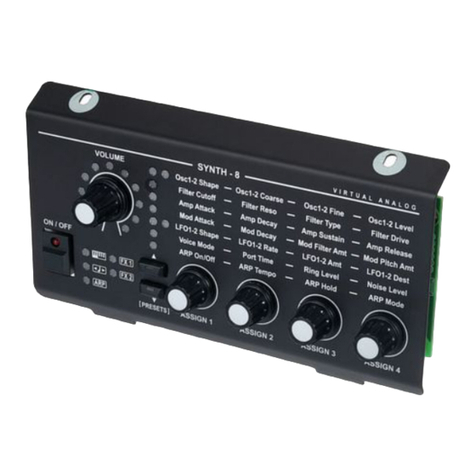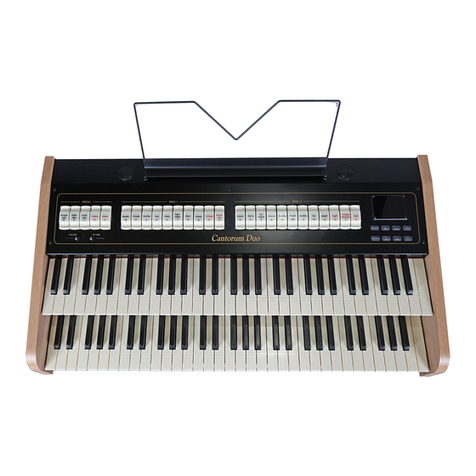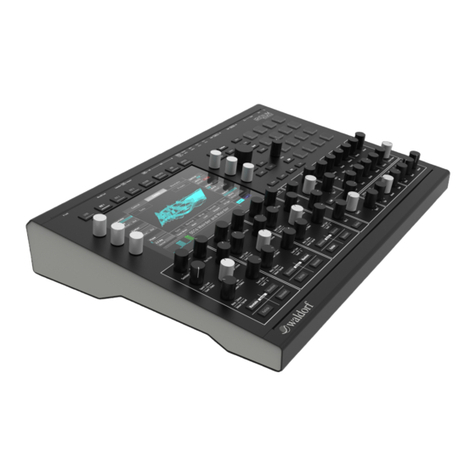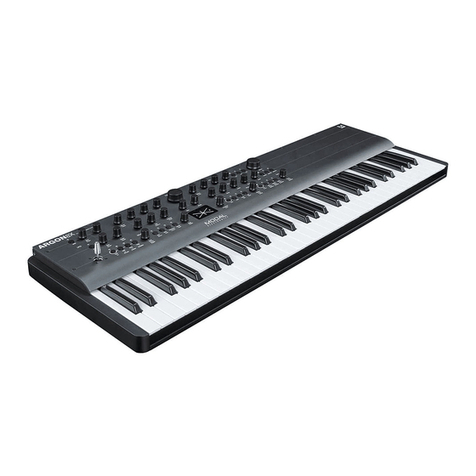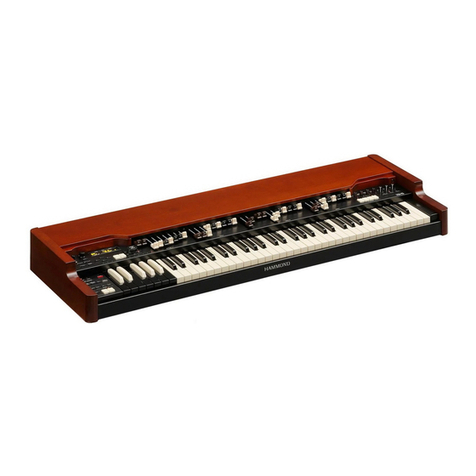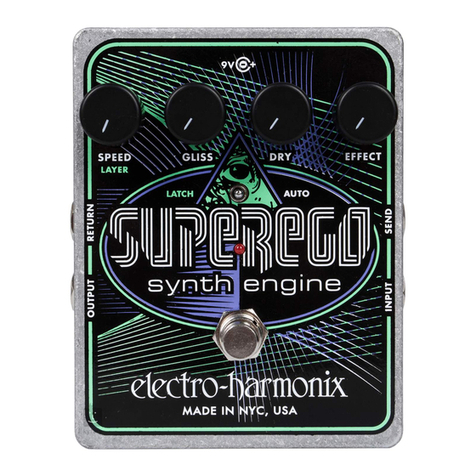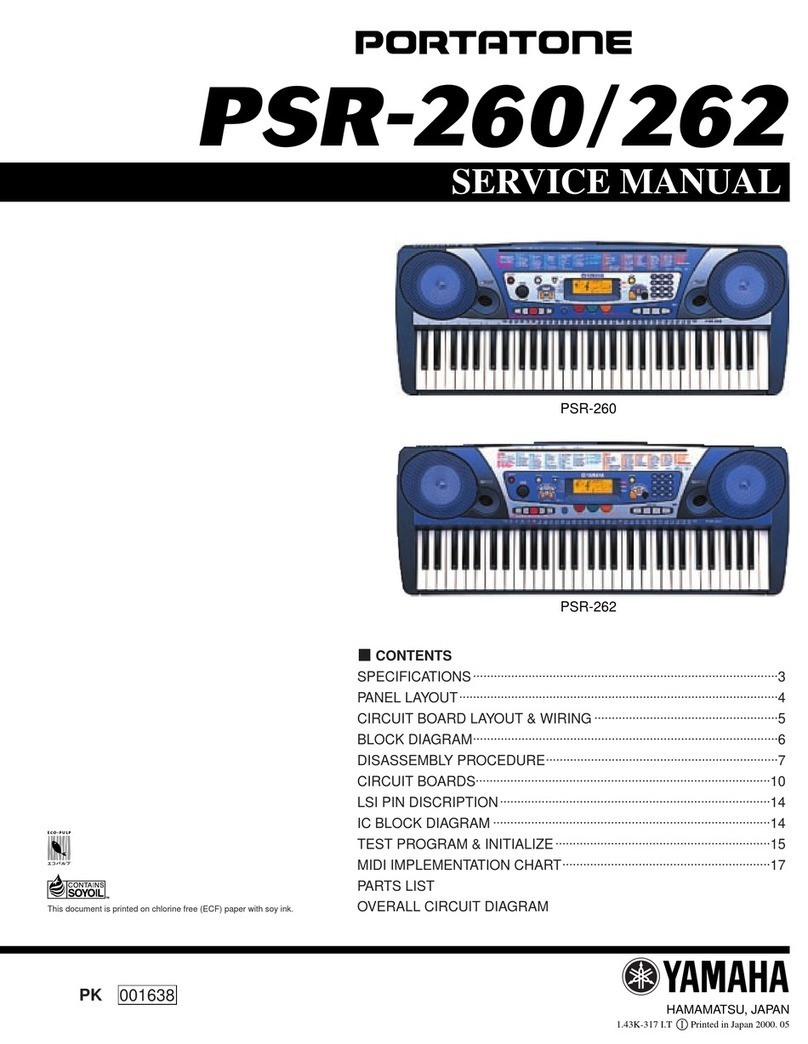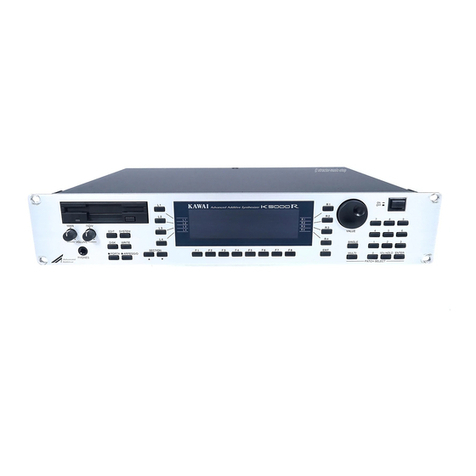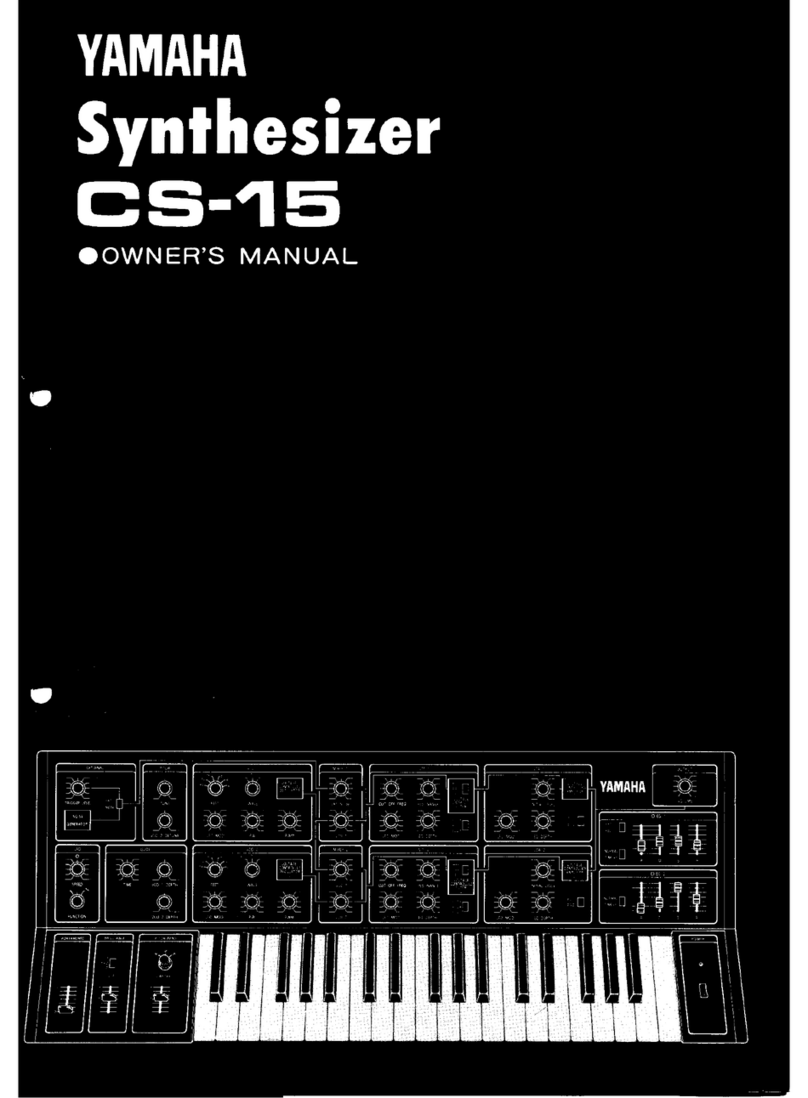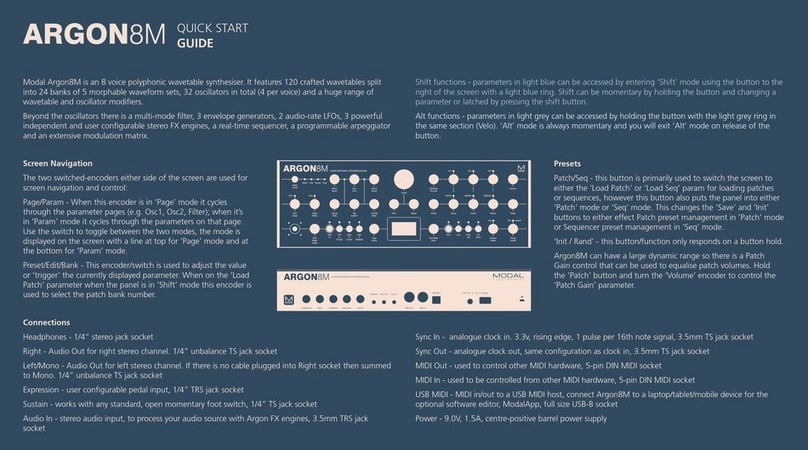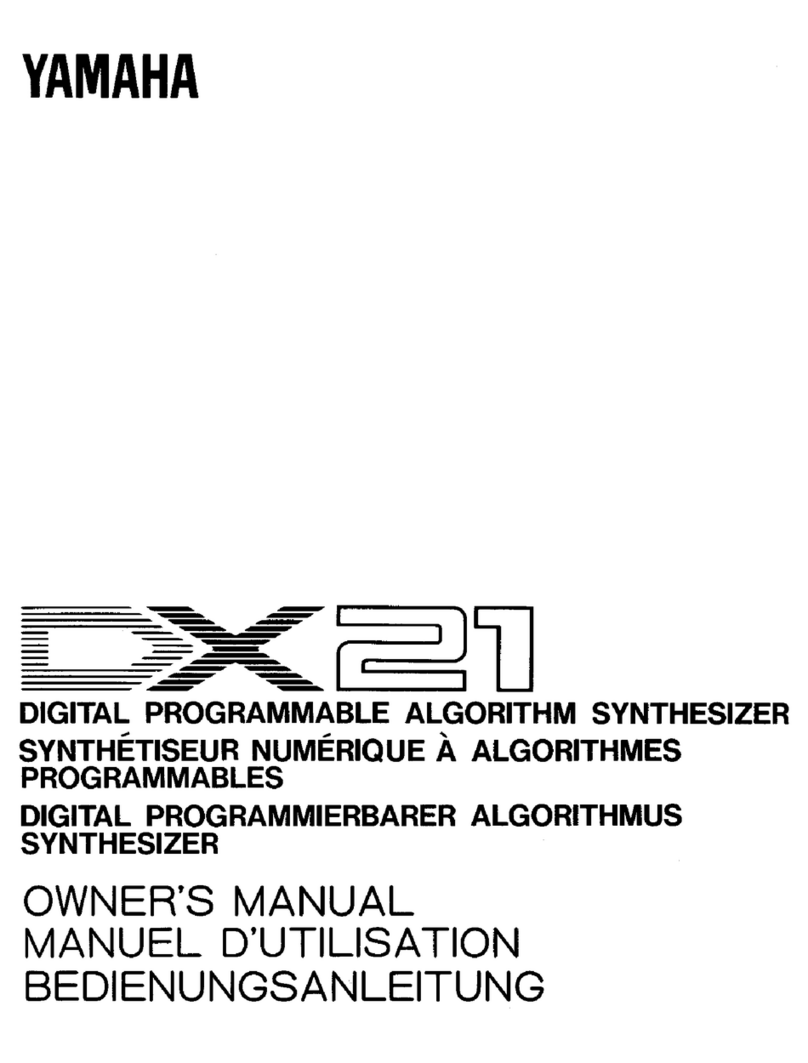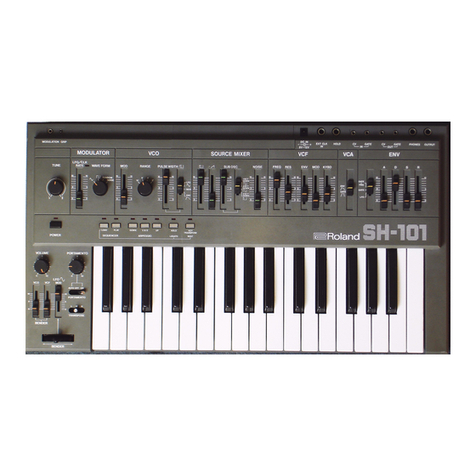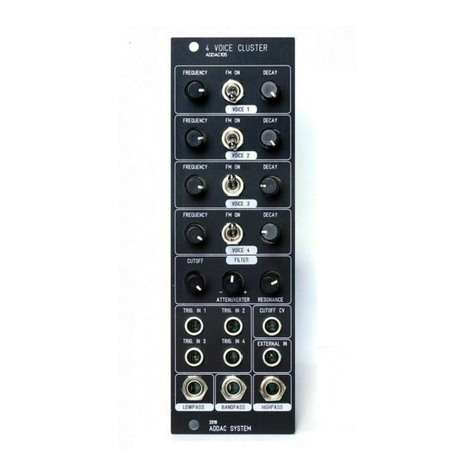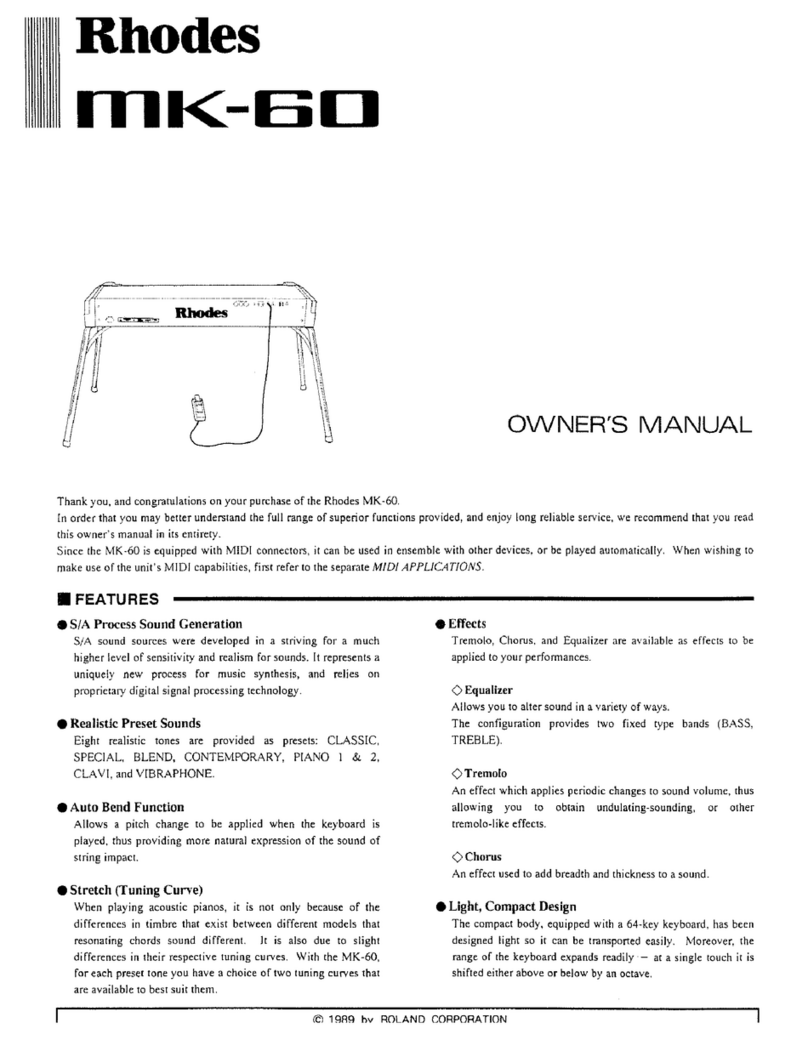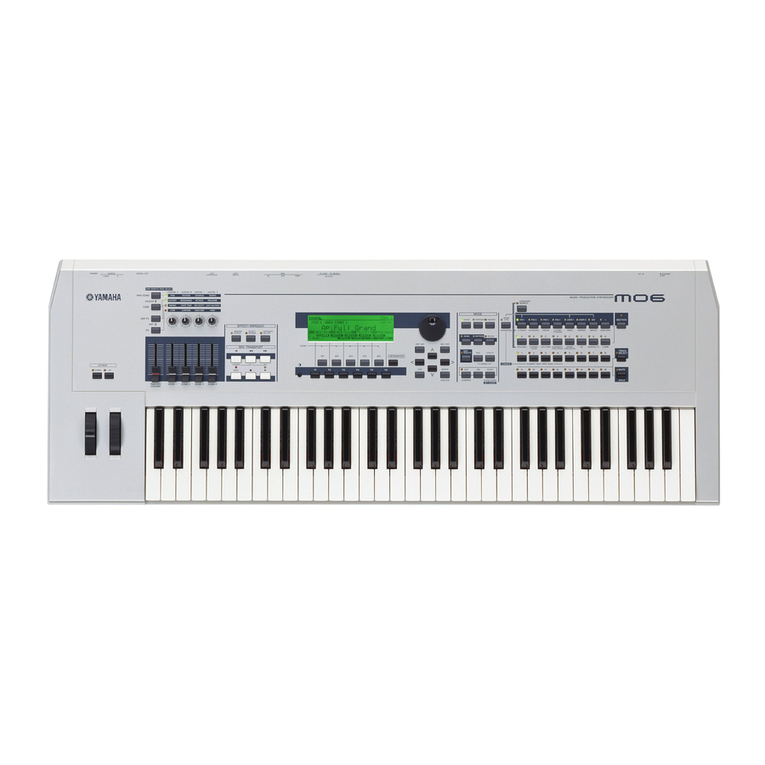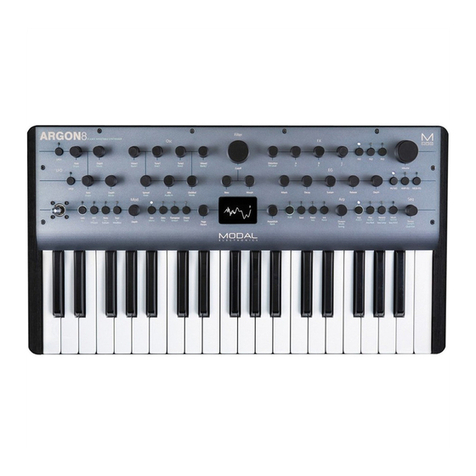Viscount Chorale 3 User manual

viscount
Chorale 3
Great
to
Pedal
Swell
to
Pedal
Tremulant Tremulant
Swell
to
Great
GREATSWELLPEDAL
GSW
ENC
SWELLGREAT/ PEDAL
User Manual
Ver. UK - 1.0

WARNING: READ THIS FIRST!
WARNING
AVIS
RISK OF ELECTRIC SHOCK
DO NOT OPEN
RISQUE DE CHOC ÉLECTRIQUE
NE PAS OUVRIR
This symbol is intended to alert the user to the
presence of uninsulated “dangerous voltage”
within the product’s enclosure that may be of
sufficient magnitude to constitute a risk of
electric shock to persons.
This symbol is intended to alert the user to
the presence of important operating and
maintenance (servicing) instructions in the
literature accompanying the appliance.
WARNING:
TO REDUCE THE RISK OF FIRE OR ELECTRIC SHOCK:
DO NOT EXPOSE THIS APPARATUS TO RAIN OR MOISTURE
AND OBJECTS FILLED WITH LIQUIDS, SUCH AS VASES,
SHOULD NOT BE PLACED ON THIS APPARATUS.
DO NOT REMOVE COVER (OR BACK)
NO USER-SERVICEABLE PARTS INSIDE
REFER SERVICING TO QUALIFIED SERVICE PERSONNEL
"INSTRUCTIONS PERTAINING TOA RISK OF FIRE,
ELECTRIC SHOCK OR INJURY TO PERSONS"
IMPORTANT SAFETY INSTRUCTIONS
SAVE THESE INSTRUCTIONS
WARNING:
1) Read these instructions.
2) Keep these instructions.
3) Heed all warnings.
4) Follow all instructions.
5) Do not use this apparatus near water.
6) Clean only with dry cloth.
7) Do not block any ventilation openings. Install in accordance with the manufacturer’s instructions.
8) Do not install near any heat sources such as radiators, heat registers, stoves
or other apparatus (including amplifiers) that produces heat.
9) Do not defeat the safety purpose of the polarized or grounding-type plug. A polarized plug has two blades with one
wider than the other. A grounding type plug has two blades and a third grounding prong. The wider blade or the third
prong are provided for your safety. If the provided plug does not fit in to your outlet, consult an electrician for
replacement of the obsolete outlet.
10)Protect the power cord from being walked on or pinched, particularly at plugs, convenience receptacles,
and the point where they exit from the apparatus.
11)Only use attachments/accessories specified by the manufacturer.
12)Use only with the cart, stand, tripod, bracket, or table specified by
the manufacturer, or sold, with the apparatus. When a cart is used,
use caution when moving the cart/apparatus combination to avoid
injury from tip-over.
13)Unplug this apparatus during lightning storms or when unused for long periods of time.
14)Refer all servicing to qualified service personnel. Servicing is required when the apparatus has been damaged
in any way, such as power-supply cord or plug is damaged, liquid has been spilled or objects have fallen into
the apparatus, the apparatus has been exposed to rain or moisture, does not operate normally, or has been
dropped.
NOTE: The socket-outlet shall be installed near the equipment and shall be easily accessible.

1
Viscount Chorale 3Owner’s Manual
INDEX
1. Important notes ..................................................................................................................................3
1.1 Looking after the product ...............................................................................................................3
1.2 Notes about the manual ..................................................................................................................3
2. Controls and connection ....................................................................................................................5
2.1 The front panel ...............................................................................................................................5
2.2 The manual splitter controls ...........................................................................................................5
2.3 The side panels ...............................................................................................................................7
2.4 Pedal board controls .......................................................................................................................8
2.5 The connections underneath the manuals.......................................................................................9
3. Main control unit .............................................................................................................................. 11
3.1 Switching on and main video page .............................................................................................. 11
3.2 An introduction to the instrument’s setup functions ....................................................................13
4. Organ Style ........................................................................................................................................15
5. Replacing voices and regulating voices volumes............................................................................16
5.1 Regulating the voices volumes.....................................................................................................16
5.2 Replacing voices ..........................................................................................................................17
5.3 Checking the stop labels...............................................................................................................19
6. Instrument general settings .............................................................................................................21
6.1 Setting the Tremulants..................................................................................................................22
6.2 Selecting the type of reverb..........................................................................................................22
6.3 Setting the equalizers ...................................................................................................................24
6.4 Signal routing on the audio outputs..............................................................................................25
6.5 Regulating the audio output volumes ...........................................................................................25
6.6 General manual settings ...............................................................................................................26
6.7 [PREV.] and [NEXT] piston settings ...........................................................................................27
6.8 Combination saving settings ........................................................................................................27
7. MIDI ..................................................................................................................................................28
7.1 Selecting the channels ..................................................................................................................30
7.2 Program Change message transmission .......................................................................................30
7.3 Setting the filters ..........................................................................................................................31
8. Utility functions ................................................................................................................................32
8.1 Factory Setting .............................................................................................................................32
9. Appendix ............................................................................................................................................35
9.1 Demonstration songs ....................................................................................................................35
9.2 Voice Local Off ............................................................................................................................35
9.3 Upgrading the operating system...................................................................................................36

2
Viscount Chorale 3 Owner’s Manual

3
Viscount Chorale 3Owner’s Manual
1.1 LOOKING AFTER THE PRODUCT
•Do not apply excessive force to the organ’s structures or the controls (knobs, stops, push-buttons,
etc.).
•When possible, do not place the instrument close to units which generate strong interference, such as
radios, TVs, computer videos, etc.
•Do not place the organ close to heat sources, in damp or dusty places or in the vicinity of strong
magnetic fields.
•Do not expose the instrument to direct sunlight.
•Never insert foreign bodies inside the instrument or pour liquids of any kind into it.
•For cleaning, use only a soft brush or compressed air; never use detergents, solvents or alcohol.
•Always use good quality screened cables for connection to amplification or diffusion systems. When
disconnecting cables from sockets, always take hold of the connector and not the cable itself; when
winding cables, do not knot or twist them.
•Before making the connections ensure that the other units (especially amplification and diffusion
systems) you are about to connect are switched off. This will prevent noisy or even dangerous signal
peaks.
•Connect the net cable to an earthed socket.
•Check that the voltage corresponds to the voltage shown on the serial number plate of the organ.
•If the organ is to be out of use for lengthy periods, disconnect the plug from the power socket.
1.2 NOTES ABOUT THE MANUAL
•Take good care of this manual.
•This manual is an integral part of the instrument. The descriptions and illustrations in this publication
are not binding.
•While the instrument’s essential characteristics remain the same, the manufacturer reserves the right
to make any modifications to parts, details or accessories considered appropriate to improve the
product or for requirements of a constructional or commercial nature, at any time and without
undertaking to update this publication immediately.
•All rights reserved; the reproduction of any part of this manual, in any form, without the manufacturer’s
specific written permission is forbidden.
1. IMPORTANT NOTES

4
Viscount Chorale 3 Owner’s Manual
•All the trademarks referred to in this manual are the property of the respective manufacturers.
•Please read all the information carefully, sothat you obtain the best performance and will from your
instrument.
•The codes or numbers in square brackets ([]) indicate the names of the buttons, sliders, trimmers and
connectors on the instrument. For example, [ENTER] refers to the ENTER button.
•Illustrations and screens showed are for information purposes only and may differ from your product.

5
Viscount Chorale 3Owner’s Manual
2.1 THE FRONT PANEL
The front panel above the two manuals contains the stops, arranged section by section, used to activate
the organ’s registers.
2. CONTROLS AND CONNECTIONS
1. [PEDAL] section: this section contains the pedal board register stops. The following couplers are
also provided:
o[Great to Pedal]: the stops of the Great will also play on the pedal board.
o[Swell to Pedal]: the stops of the Swell will also play on the pedal board.
2. [GREAT] section: contains the stops and tremolo of the Great and the tremulant:
o[Swell to Great]: the stops of the Swell will also play on the Great.
3. [SWELL] section: Swell stops and tremulant.
2.2 THE MANUAL SPLITTER CONTROLS
The pistons of the adjustable combinations, Tutti and other accessory functions are placed in the areas
between the manuals.
HR123456 CA.P
S
MIDI
P
MIDI
G
MIDI
SW
PREV NEXT
ENC T
Chorale 3
3 5 109 4 1 8 6
1. General combinations: this section contains the instrument’s general adjustable combinations.
When a combination is recalled, the light of the relative stop illuminates to confirm its activation.
The [NEXT] pistons can also be used to select combinations one by one in an upward direction and
[PREV.] for the same function in a downward direction (combination sequencers).
There is also a piston marked [HR] (Handle Registers) beside the general and dedicated combinations;
lso known as 0, when it is on it automatically memorises the register status. This piston’s main
function is to restore, during use of the combinations, the “hand-made” stop setup created when the
[HR] button was on.
1 2 3

6
Viscount Chorale 3 Owner’s Manual
Remember that an HR setup is not modified if the stops are switched on and off by hand when a
combination on the same section is selected (i.e. with the HR off).
N.B.
The contents of the HR are not retained when the organ is switched off.
Each combination (including HR and Tutti) is able to store:
-the status (on/off) of the stops
-the status of the couplers (enabling saving, see point 6.8)
-the status of the tremulants (even with different modulation depths and speeds, if the specific
SET-UP menu function described in par. 6.8 is activated)
-the style (Organ Style)
-the MIDI controls (point 3) and the Program Changes set using the SEND PROGRAM
CHANGE function (par. 7.2)
-the All Swells on Swell and Automatic Pedal, by activating the specific function, see par. 6.8.
For the fixing combinations procedure, see point 2.
2. [S] piston: “Set” (or fix) function used for fixing combinations. To fix a combination, simply press
the [S] piston, keep it pressed and then press the combination or Tutti you wish to fix.
3. [MIDI G], [MIDI SW] and [MIDI P] buttons: this section contains the pistons used to activate the
transmission of MIDI note codes on the [MIDI OUT] port (in the recess underneath the Great) in
response to the notes played on the manuals. The LED of each piston displays the status of transmission
on the relative MIDI channel as follows:
oPiston illuminated: note code transmission enabled
oPiston off: note code transmission disabled
[MIDI G] controls transmission of the notes played on the Great, [MIDI SW] controls the notes
played on the Swell, and [MIDI P] the notes played on the pedal board.
N.B.
-These pistons activate or deactivate the transmission of MIDI note codes (Note On and Note
Off) only, unlike all the other MIDI messages the organ is able to process, which are always
transmitted regardless of the status of this function.
-These pistons control transmission of MIDI notes only. Reception is always enabled.
4. [NEXT] and [PREV.] stops: general combination sequencers. [NEXT] selects combinations in
ascending order, [PREV.] in descending order.
5. [A.P.] piston: this piston controls the status of the Automatic Pedal function used to play the stops of
the pedal board using the first 32 notes of Great. In this case, the organ’s pedal board is deactivated
and the stops become monophonic, with priority to the lowest note.

7
Viscount Chorale 3Owner’s Manual
6. [ENC] piston: pressing this piston activates the Enclosed function used to control the organ’s general
volume using the swell pedal [SWELL].
N.B.
When the Enclosed function is activated, the volumes of the Great and pedal board are immediately
set in relation to the position of the [SWELL] swell pedal. When the Enclosed function is deacti-
vated, the volumes of the above sections are immediately reset in relation to the position of the
[GREAT / PEDAL] swell pedal.
7. [T] piston: piston used for switching the Tutti on and off.
The voice composition of the Tutti function is programmable. To set a new configuration, switch on
the stops and couplers of your choice, press [S], keep it pressed and then press the [T].
8. [C] piston: Cancel piston, which switches off all the stops, tremolos and pistons under the Choir
active, then resets the general HRs.
2.3 THE SIDE PANELS
Other organ controls such as the volume controls, reverb adjustment and the graphic display showing all
the instrument’s main setup and adjustment functions are located on the right and left of the manuals, in
easy reach of the organist.
To make use of these controls quicker and easier, all the rotary trimmers are on the left of the manuals,
with the graphic display and the relative control buttons on the right.
LEFT PANEL
MAN.IPEDAL
REVERB
POWER
GENERAL
1 2
3 4
5
1. [GENERAL] trimmer: regulates the organ’s general
volume.
2. [REVERB] trimmer: regulates the level of the reverb digital
effects.
3. [PEDAL] trimmer: pedal board volume.
4. [GREAT] trimmer: Great volume.
5. [POWER ] Switch: the switch used to switch the organ on
and off.
WARNING!
Do not switch the organ on and off in rapid succession. After the instrument is switched off, wait at
least 10 seconds before switching it back on.
GREAT

8
Viscount Chorale 3 Owner’s Manual
RIGHT PANEL
VALUE
-
+
FIELD
FIELD ENTER
EXIT
VALUE
1
24
3
1. Display: graphic display of 128x64 pixels for display of all
the screens relating to the organ’s functions.
2. [FIELD S] and [FIELD T] buttons: buttons used to move
the cursor around within the display screens. The [FIELD S]
button moves the cursor to the field above (the one currently
selected) while [FIELD T] selects the field below.
3. [VALUE +] and [VALUE -] buttons: buttons for adjusting
parameters. [VALUE +] increases the value, [VALUE -]
decreases it.
4. [EXIT] and [ENTER] buttons: buttons for accessing or
exiting menu screens. [ENTER] is used to enter the menu or
function shown on the display or confirm any prompts from
the system. [EXIT] is used to exit the screen on the display
and return to the previous one, or abort any prompts from the
system.
2.4 PEDAL BOARD CONTROLS
MAN. I / PEDAL MAN. II
1 2
1. [GREAT / PEDAL] pedal: swell pedal used to control the volume of the Great and pedal board.
2. [SWELL] pedal: you can use this swell pedal to control the volume of the Swell.
GREAT / PEDAL SWELL
N.B.
The trimmer volume controls on the left of the manuals allow balancing of the sections; once you
have set the levels best suited to your taste and the sound balance you require, they will not require
frequent adjustment.
The swell pedals, on the other hand, allow continuous control of the volumes, enabling you to
obtain all the dynamic effects you wish. Apart from regulating the volume, the swell pedals also
simulate the variation in timbre of the stops which would occur in the swell boxes of pipe organs.

9
Viscount Chorale 3Owner’s Manual
2.5 THE CONNECTIONS UNDERNEATH THE MANUALS
In the left of the organ, under the surface which contains the manuals and side panels, there is a small
recess containing various connectors for connecting the organ to remote sound and MIDI devices.
THRU OUT
MIDI
IN L(MONO)
INPUT
R L(MONO)
OUTPUT
R
HEADPHONES
1 2 3 4
1. [HEADPHONES] connector: Jack socket to which a headphone set can be connected. With
headphones connected, the organ’s internal amplification is cut off.
2. [MIDI] connectors: five-pin DIN connectors for connection of instruments with MIDI interface.
The [IN] connector allows receipt of MIDI data generated by remote MIDI sources, the [OUT]
connector transmits the MIDI messages generated by the Chorale 3, and the [THRU] connector
transmits the MIDI data exactly as received at the [IN] connector.
N.B.
To obtain the best results from the [HEADPHONES] output, phones with impedance of at least 16
Ω
should be used.
3. [INPUT] connectors: RCA line inputs which allow other instruments to be played using the organ’s
internal amplification. If the source is monophonic use the L(MONO) connector only.
4. [OUTPUT] connectors: RCA line outputs for the unamplified signal, for connection of optional
amplified speakers, remote amplification systems or recording systems. To use a monophonic signal,
connect to the [L/(MONO)] connector only.

10
Viscount Chorale 3 Owner’s Manual
In the right there are two more pairs of line audio outputs.
The main difference between these outputs and the ones in the recess underneath the manuals is that the
latter contain the signal generated by the organ, while on the rear connectors, the signals of the individual
manuals and pedal board are routed to and adjusted on the individual outputs in accordance with the
relative settings on the display (for more information see points 6.4 and 6.5).
L(+R) R L(+R) R
OUTPUT 1 OUTPUT 2
1
1. [OUTPUT 1] and [OUTPUT 2] connectors: Jack line outputs carrying the organ signal in accordance
with the routing set by means of the function on display. With the Factory Settings active, the signals
are distributed as follows:
-[OUTPUT 1]: General signal
-[OUTPUT 2]: Reverb only

11
Viscount Chorale 3Owner’s Manual
3. MAIN CONTROL UNIT
As described in the previous section, the right-hand panel beside the manuals contains the main control
unit for all the Chorale 3’s internal functions. The organ features a large set of control functions allowing
the user to customise the instrument in the most suitable way, adapting it to his or her own requirements.
These are not mere general settings, but setup functions that configure every part of the organ: for the
sound setup, for example, the user can select the instrument’s musical style, or change the registers
assigned to the stops and then regulate their individual volumes. The levels, equalisation and channel
routing of the remote outputs can also be adjusted. The organ also allows complete, unrestricted
configuration of the MIDI interface, as well as the familiar settings of the tremolo and reverb effects, the
manuals and the pedal board, the internal graphic equalizer and the piston functions.
3.1 SWITCHING ON AND MAIN VIDEO PAGE
When the organ is switched on using the [POWER] switch on the left-hand panel, the instrument becomes
operational after a few seconds, during which time all the amplification circuits are activated and the
internal systems are configured. While this is taking place, the display shows the introductory screen on
which the release of the firmware installed on the instrument can always be checked.
After the switch-on procedure is complete, the main video page will be displayed:
containing the following display fields:
oMEMORY BANK: this parameter can be used to select one of the eight memory banks for saving
the general and/or specific combinations.
Therefore, as well as providing a total of 48 general, this function is especially useful if the instrument
is used by more than one organist, since each of them will be able to save his or her own programming
settings in a different Memory Bank.
oTRANSPOSER: key transposer with a range of +5 / -6 semitones (adjustments in steps of one
semitone).
oTEMPERAMENT: this parameter allows the selection of a series of historic temperaments of different
eras and national origins. You can choose from EQUAL, a temperament with perfect tuning, or the
classical KIRNBERGER, WERCKMEISTER, PYTHAGOREAN, MEANTONE and
VALLOTTI temperaments.
oENSEMBLE: this parameter can be used to set six levels of natural tiny differences in pitch between
one organ pipe and another, in order to simulate the tuning errors that occur in the organ’s pipes due
to wear over time and variations in temperature. If you wish to use the registers perfectly tuned, select
the – value.
oMENU SETTING: selection field for access to all the organ’s internal setup functions.

12
Viscount Chorale 3 Owner’s Manual
HOW TO MOVE AROUND INSIDE THE SCREENS
The screen cursor is in the form of the field displayed in reverse; in the screen shown above, for example,
the cursor is located on the MEMORY BANK parameter.
As explained in point 2.3, to move the cursor use the [FIELD S] and [FIELD T] buttons.
[FIELD S] moves the cursor to the field above, [FIELD T] locates it on the one below.
If a menu consists of more than one screen, an arrow symbol indicating that previous and/or subsequent
pages are available will appear in the top right-hand corner.
there are pages after the one currently displayed
there are pages before the one currently displayed
there are pages before and after the one currently displayed
To access a submenu or a function, press the [ENTER] key; to exit the current screen use the [EXIT]
button.
To adjust parameters or select the various settings / options, use the [VALUE +] and [VALUE -] buttons.
A BRIEF NOTE ON TEMPERAMENTS
In the “natural” tuning system, based on the acoustic phenomenon of harmonic sounds, two important musical intervals, the
major third and the perfect fifth, cannot be made to coexist in the “pure” state (i.e. beat-free). Therefore, over the centuries a
variety of compromise solutions known as TEMPERAMENTS have been invented and realised. These give priority to one or
the other interval by modifying them in various ways.
In the ancient world and the Middle Ages, until the last few decades of the 17th Century, the “Pythagorean” tuning system, in
which the fifths were retained perfectly pure, was in use. The resulting major third was particularly unattractive in sound, and
was therefore treated as a dissonance.
However, the music of the time was mainly monodic, and the early forms of vocal and instrumental polyphony made a great
deal of use of the interval of a fifth. With the early Renaissance, and the start of the great flowering of vocal polyphony, the
interval of a major third gradually came to be heard as consonant and not dissonant. The instruments with fixed tuning, such
as the organ and harpsichord, gradually adapted to this situation by adopting a system of temperament known as “Meantone”,
which gave the major third priority over the fifth. This temperament is particularly important because it was the temperament
in normal use in Europe in the 16th and 17th Centuries, until the early 18th Century. Here are the six temperaments available on
the Chorale 3, first and foremost the MEANTONE.
MEANTONE
- 8 pure major thirds: E flat - G / B flat - D / F - A / C - E / G - B / D - F # / A - C# / E - G.
- 4 unusable major thirds (diminished fourths): B - D# / F# - A# / C# - E# / A flat - C.
- 1 fifth known as the “wolf” (very dissonant extended fifth): A flat - E flat.
- Highly irregular chromatic scale (meaning that chromatic compositions are given a very distinctive voice)
- Keys usable with this temperament: C maj. / D maj. / G maj. / A maj. / B flat maj. and the relative minors.
The temperaments which follow allow all the major and minor keys to be used, although those with the most alterations have
a highly distinctive voice, in contrast with the modern equal temperament.
WERCKMEISTER
This temperament, invented by the organist and musical theorist Andreas Werckmeister, is recommended for performing the
German musical repertoire of the late 1600s.
KIRNBERGER
This temperament, developed by Johann Philipp Kirnberger, pupil of J.S. Bach, is also suitable for playing the German

13
Viscount Chorale 3Owner’s Manual
baroque composers and the works of Bach.
PYTHAGOREAN
In this temperament, all the fifths are natural except for the “wolf” fifth, in the interval A flat - E flat, which is greatly
diminished.
It dates from the Middle Ages up to the 15th century, and can therefore be used for compositions of that period.
VALLOTTI
This Italian temperament invented by Francescantonio Vallotti was later taken up in England by Thomas Young. It can be
used effectively for the Italian 18th Century repertoire, and also for the English repertoire of the same period.
3.2 AN INTRODUCTION TO THE INSTRUMENT’S SETUP FUNCTIONS
Selecting the MENU SETTING display field in the main screen accesses the menu containing all the
organ’s setup functions. The first video page displayed is as follows:
scroll the cursor downwards using the [FIELD T]button to display the second part of the menu:
The display options are:
oORGAN STYLE: selection of the organ’s musical style.
oVOICES: setup functions for all the organ’s voices, such as loading of alternative voices, volume
adjustment and checking of the register stops.
oSETUP: this submenu contains all the organ’s general settings, such as adjustment of the tremolos
and equalisers, selection of the type of reverb, adjustment of the real output signals, and setup of the
manuals and the pistons on the section control boards.
oMIDI: setup of the organ’s MIDI interface.
oUTILITY: utility functions such as adjustment of the instrument’s fine tuning, and display contrast
and recall of the Factory Settings.
oDEMO SONG: collection of a number of demonstration tracks.

14
Viscount Chorale 3 Owner’s Manual
To access the submenu of your choice, select the relative display field using the [FIELD S] and [FIELD
T] buttons and press [ENTER]. Use the [EXIT] button to return to the main video page.
For a clearer view of the various submenus, the table below summarises the way in which all the organ’s
functions are organised.
ORGAN STYLE
Organ Style selection
VOICES
Voices Volume
Pedal Voices Volume
Great Voices Volume
Swell Voices Volume
Alternative Voice
Pedal Alternative Voice
Great Alternative Voice
Swell Alternative Voice
Sound Check
Sound Check
SETUP
Tremulant
Tremulant setting
Reverberation
Reverberation Style
External Out Router
External Out Router setting
External Out Volume
External Out Volume setting
Keyboard Setting
GT/SW Keyboards Inversion setting
Key Velocity setting
Prev. / Next Pistons Setting
Prev./Next Pistons Action setting
Function Stored into Pistons
Tremulant Depth and Speed setting
Enclosed and A.P. setting
Couplers setting
MIDI
TX / RX Channel
Pedal channel setting
Great channel setting
Swell channel setting
Send Program Change
Pedal PG setting
Great PG setting
Swell PG setting
TX / RX Filter
Control Change filter setting
Program Change filter setting
Sys-Ex filter setting
Real Time filter setting
UTILITY
Tuning setting
Factory Setting
LCD Contrast setting
MENU SETTING
DEMO
Entire Organ Factory Setting
Single Organ Style Factory Setting
Demo song selection
Equalizer
Internal Equalizer setting
External Equalizer setting

15
Viscount Chorale 3Owner’s Manual
4. ORGAN STYLE
One important feature of the Chorale 3 series is the availability of different organ styles, Baroque, Romantic,
French, American, plus two user-defined styles, which allow you to set the sound configuration perfectly
suited to the literature you intend to perform.
Moreover, each style automatically saves the modifications made to the sound setup using the voice
replacement functions and voice volume adjustments. This means that each style can be modified and
customised to personal taste, making the organ extremely flexible.
The screen used to select the organ style required can be accessed by selecting the ORGAN STYLE
option in the SETTING MENU:
After selecting a style, you will need to check whether the front panel stops and registers still correspond,
since most of the voices will have changed (especially when you select styles from different historic
periods).
To check the voice - stop correspondence, recall the SOUND CHECK function described in point 5.3.
As described in the instruction to this section, it is important to remember that the Organ Styles save the
status of the following functions:
- Alternative Voice (voices assigned to each stop)
- Voice Volume (volumes of the voices)
- Reverberation (type of reverb effect)
- Internal Equalizer (equalizer for the internal amplification system)
- External Equalizer (equalizer for the rear audio outputs)

16
Viscount Chorale 3 Owner’s Manual
5. REPLACING VOICES AND REGULATING VOICE VOLUMES
One important new feature of the Chorale 3 series is the capability for replacing the voices initially
associated to the front panel stops with other voices already provided in the organ’s internal memory.
In practice, this gives quick, easy voice replacement, which however enables you to set your organ’s
entire sound setup exactly as you wish and at any time, with considerable advantages for the customisation
of the instrument, and for its use by more than one organist (each of them will be able to have their own
set of voices). The register setup can be further adjusted to individual requirements through regulation of
the volume of each individual voice.
All voice management functions can be recalled by selecting the VOICES field in the SETTING MENU.
The video page displayed is as follows:
containing the following functions:
oVOICES VOLUME: regulates the volume of the voices.
oALTERNATIVE VOICE: used to replace voices.
oSOUND CHECK: checks the voices associated to the stops.
To display the function required, select the relative display field using the [FIELD S] and [FIELD T]
buttons and press [ENTER]. Use the [EXIT] button to return to the SETTING MENU.
5.1 REGULATING THE VOICE VOLUMES
The VOICES VOLUME function allows you to adjust the volume of each individual voice in a range
from -9 dB to +9 dB. Each modification is saved immediately and is audible in real time, making it easier
for the user to obtain the setting required. You must also remember that the voice volumes are saved by
the organ styles, so when a style change is made, apart from possible replacements of the stop voices, the
volumes will also be reconfigured to suit the selected style.
However, changes made to the volumes are not lost when different styles are recalled and they are retained
in the memory within the style.
To recall this function, select the VOICES VOLUME option from the SETTING MENU; the display will
show:

17
Viscount Chorale 3Owner’s Manual
containing the organ’s three sections.
Select the section containing the voice the volume of which you wish to adjust or press its stop on the
front panel.
The display shows the first four voices in the section recalled (and the stop number); now use the
[FIELD S] and [FIELD T] buttons to select the voice required.
If you have recalled the voice using the stop, the voice and its volume will be displayed immediately.
To regulate the volume, use the [VALUE +] and [VALUE -] buttons.
The new value is rendered audible immediately and saved; press [EXIT] to return to the previous screen.
IMPORTANT NOTES
-The volumes of the individual voices are automatically saved in the current Organ Style (see
also section 4). This means that when another style is recalled, the volumes will be reset to the
values described in the last style recalled. When the style in which the voice volumes were
changed is reloaded, the volumes will be reset to the latest adjustments.
-To restore the original volumes of all the styles or one in particular, recall the FACTORY SETTING
function described in point 8.1.
5.2 REPLACING VOICES
As described at the start of this section, the Chorale 3 has an interesting, useful voice replacement function.
The organ has a vast internal library of voices, comprising various variations on the original voices.
To recall this function, select the ALTERNATIVE VOICE option from the VOICES submenu; the display
will show the first screen:
in which you have to select the section of the organ containing the stop of the voice to be replaced, or
press the stop itself on the front panel (as if to switch it on). In the first case the display shows the first
four voices in the section selected.

18
Viscount Chorale 3 Owner’s Manual
while if you press the stop the display shows the screen shown below.
Now use the [FIELD S] and [FIELD T] buttons to select the voice you wish to replace. After locating
the cursor on the voice concerned, press [ENTER].
The top of the display contains information concerning the voice you are about to replace, while the
central part of the screen shows the possible replacement registers for that specific stop.
Here again, you can use the [FIELD S] and [FIELD T] buttons to scroll through all the replacement
voices, which are rendered audible immediately for quicker programming by just moving the cursor over
the fields of the voices displayed.
Once you have found the voice you require, press [ENTER]:
the system now provides information about the voice to be replaced (in the top of the screen) and the new
voice (in the middle), and a prompt for confirmation to proceed, since the new register has not yet been
definitively loaded, but has simply been rendered audible for evaluation. As the display shows, press
[ENTER] to confirm the replacement or [EXIT] to abort.
If you now go ahead with the operation, the system will definitively replace the old voice and give
confirmation with the following screen:
Table of contents
Other Viscount Synthesizer manuals
